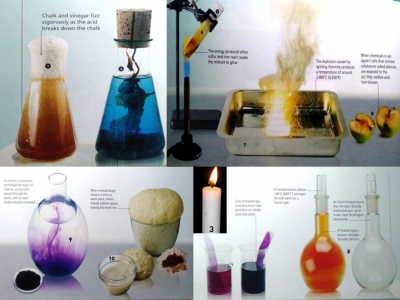
CHEMICAL REACTIONS
The atoms within a molecule are held together with links called chemical bonds. In a chemical reaction, the bonds between a molecule’s atoms break, and the atoms bond in a different way to form new molecules. In some reactions, elements combine to create a compound. In others, compounds break down into elements or simpler compounds. All the atoms from the original substance exist in the changed substance, but in different places.
- REACTION When vinegar (acetic acid) and chalk (calcium carbonate) are mixed, a chemical reaction takes place. The acidic vinegar breaks down the chalk to release carbon and oxygen as bubbles of carbon dioxide. The starting materials in a chemical reaction are called reactants. The materials that exist after are called products.
- DISPLACEMENT In a displacement reaction, the metal that forms part of a compound is removed and replaced by another metal. When a coil of copper is dipped into a clear solution of silver nitrate, the copper displaces the silver from the solution to form a blue solution of copper nitrate and needles of solid metal silver.
- BURNING When the wick of a candle burns, it is reacting with oxygen in the air to produce ash and smoke. The burning also produces energy in the form of heat and light. In all reactions, energy is used up when bonds between atoms break, and energy is released as new bonds are made.
- REACTION RATES The rate of a chemical reaction is affected by factors such as temperature, pressure, light, surface area, and concentration. It is possible to change the rate of a reaction by varying one of these factors. For example, increasing the concentration of dye in a solution will dye the material more quickly.
- REVERSIBLE A few reactions are reversible. The molecules created by the reaction can be reformed into the original materials. The initial reaction is called the forward reaction and the reverse is the backward reaction. Dinitrogen tetraoxide breaks down into nitrogen dioxide when heated, but reverts when cooled.
- APPLYING HEAT When a mixture of yellow powder sulfur and silver-grey iron filings is heated to a high temperature, a chemical reaction takes place and iron sulfide is formed. Without heat, the substances would not react with each other. Heat speeds up most reactions, and cold slows reactions down.
- EXOTHERMIC Thermite is a mixture of aluminium and iron oxide. When it is ignited at a high temperature there is an explosion, as the chemical reaction produces a sudden release of energy in the form of light, heat, and noise. Reactions that produce heat are known as exothermic reactions.
- OXIDATION Some chemical reactions happen around us naturally. One of the commonest reactions is oxidation – when substances gain oxygen. Oxidation is happening when metals rust, when wood burns, and when we breathe. In all these reactions, substances are reacting with oxygen from the air.
- SOLUTIONS A solution is a mixture in which the molecules are mixed so evenly and completely that it seems like a single substance. However, in a solution, a chemical reaction has not taken place. Neither the solute (the substance being dissolved) nor the solvent (the substance that it is dissolved in) have changed.
- CATALYST A catalyst is a molecule that helps bring about and speed up a chemical reaction, but does not change itself during the reaction. Natural catalysts are called enzymes. Bread dough rises because enzymes in yeast cause a reaction that produces bubbles of carbon dioxide when it is mixed with water and sugars.
Picture Credit : Google



